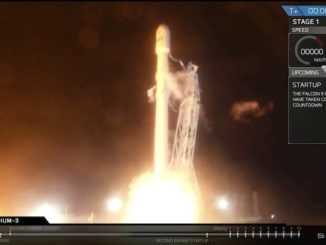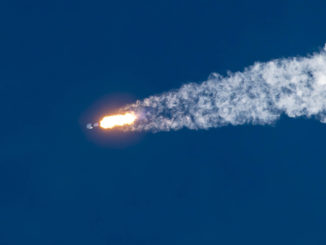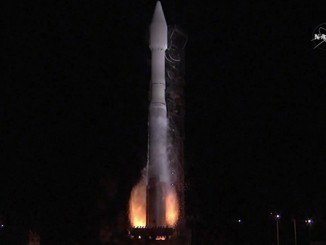
An attempt to place a small North Korean military spy satellite into orbit May 30 failed a few minutes after liftoff, five days after South Korea successfully launched the country’s homegrown Nuri rocket with several technology demonstration and scientific research spacecraft.
The North Korean launch attempt May 30 intended to place a military reconnaissance satellite into orbit using a new liquid-fueled launch vehicle called Chollima 1. In an unusual acknowledgement of failure, North Korea’s state-run news agency said the rocket fell in Yellow Sea west of the Korean Peninsula after lifting off at 5:27 p.m. EDT (2127 UTC) May 30 from the Sohae Satellite Launching Station near North Korea’s northwestern border with China.
The launch occurred at 6:27 a.m. local time May 31 in North Korea.
The official North Korean news report said the rocket crashed back to Earth after “losing thrust due to the abnormal starting of the second stage engine after the separation of the first stage.”
North Korea’s government news agency attributed the failure to the low reliability of the new engine system used on the Chollima 1 rocket, and the “unstable character” of the fuel. Officials are investigating the cause of the malfunction before launching the next flight of the rocket.
The payload on the Chollima 1 rocket was North Korea’s Malligyong 1 military spy satellite. Photos released by North Korea before the launch showed dictator Kim Jong Un inspecting the satellite, which appeared to be about the size of a refrigerator, larger than the two small spacecraft the country placed into orbit in 2012 and 2016.
South Korea’s military said it was recovering an object presumed to be part of the North Korean launch vehicle about 120 miles (200 kilometers) west of Eocheong Island in the Yellow Sea. Photos showed the object to be a white metal cylinder, possibly part of the first stage of the Chollima 1 rocket.
In a statement, South Korea’s military said it plans to inspect the debris to learn more about the technology used in North Korea’s rocket program, including an assessment of whether foreign parts were used on the launch vehicle. Previous reports have linked North Korea’s rocket program with the use of Russian and Ukrainian engine technology.

The White House condemned North Korea’s May 30 launch as a violation of UN Security Council resolutions, saying the launch raises tensions and risks destabilizing the security situation in the region. “This claimed space launch involved technologies that are directly related to the (North Korean) intercontinental ballistic missile program,” the White House said in a statement.
The North Korean satellite launch attempt occurred five days after South Korea successfully sent a batch of small satellites into orbit with the country’s all-domestic Nuri rocket.
The launch was the third flight of South Korea’s Nuri rocket, and the second successful Nuri launch after the inaugural flight faltered before reaching orbit. The most recent Nuri launch took off at 5:24 a.m. EDT (0924 UTC) May 25 from the Naro Space Center, on an island nearly 300 miles (500 kilometers) south of Seoul.
The 155-foot-tall (47.2-meter) Nuri rocket headed south from the Naro launch base with four kerosene-fueled KRE-075 engines generating more than 600,000 pounds of thrust. Second and third stage engines completed the task of accelerating the Nuri rocket’s payloads into a polar orbit about 340 miles (550 kilometers) above Earth, according to the Korea Aerospace Research Institute.
The third flight of South Korea’s Nuri rocket marked the first time the launcher hauled a “commercial-grade” satellite into orbit. The previous two launches carried satellite mockups and small CubeSats.
The main payload on the May 25 launch was NEXTSat 2, a 397-pound (180-kilogram) technology demonstration satellite that will test a South Korean-made synthetic aperture radar instrument for all-weather imaging of Earth’s surface. NEXTSat 2 was developed by the Satellite Technology Research Center at the Korea Advanced Institute of Science and Technology.
The Nuri rocket carried seven smaller CubeSats, including a four-satellite formation of 22-pound (10-kilogram) spacecraft called SNIPE from the Korea Astronomy and Space Science Institute to study space weather. Ground teams received signals from three of the four space weather research CubeSats, but the fourth spacecraft may not have deployed from the rocket.
Three other CubeSats were launched on the Nuri rocket to study the radiation environment in Earth orbit, test an Earth-observing camera, and to study weather phenomena.

The Nuri rocket program, also called KSLV 2, is a follow-up to the Naro 1 rocket developed in a partnership between Russia and South Korea.
The first two Naro 1 rockets failed in 2009 and 2010, but the third Naro 1 mission in 2013 successfully deployed a small South Korean technology demonstration satellite, making South Korea the 11th country to launch its own satellite into orbit, but the feat was not accomplished without international help.
Russia’s space contractor Khrunichev developed the Naro 1’s first stage, and the booster’s kerosene-fueled RD-151 main engine was built by NPO Energomash, another Russian company. Russia and South Korea ended the Naro 1 program after the 2013 test flight.
Korea Aerospace Industries led the South Korean industrial team responsible for developing the Nuri rocket, which can deliver a payload up to 4,850 pounds (2.2 metric tons) to a 300-mile-high (500-kilometer) polar orbit.
The rocket’s KRE-075 engines, developed by the South Korean company Hanwha Aerospace, each use a gas generator to drive a pump feeding propellant into the thrust chamber. SpaceX’s Merlin engines, which power the Falcon 9 rocket, use a similar design.
More than 300 South Korean companies have participated in the Nuri rocket program.
The launch May 25 was the first Nuri rocket flight with co-management by Hanwha, which the South Korean government selected last year to take over responsibility for manufacturing and launch operations. For this launch, Hanwha was in charge of manufacturing and jointly responsible for launch operations alongside government officials.
South Korea plans more Nuri launches in the next few years, with the next flight slated for 2025 with a high-resolution South Korean Earth observation satellite. Hanwha will be responsible for the entire launch operation by the sixth launch of the Nuri rocket, currently scheduled for 2027.

The entry into service by the Nuri rocket comes as South Korea is advancing its space program to explore the moon. South Korea’s first lunar orbiter, named Danuri, launched last year on a SpaceX Falcon 9 rocket. Danuri is about halfway through its one-year primary mission at the moon, regularly taking images and collecting data on surface composition and ice deposits.
South Korea is in the early stages of developing a bigger rocket, called the KSLV 3, that officials hope to launch in 2030. The KSLV 3 will be larger than the Nuri rocket, capable of hauling up to 15,400 pounds (7 metric tons) of payload into a polar orbit, more than three times the carrying capacity of the Nuri rocket.
The KSLV 3 rocket will also incorporate reusable components, and will launch South Korea’s first robotic moon landing mission in the early 2030s.
Email the author.
Follow Stephen Clark on Twitter: @StephenClark1.



